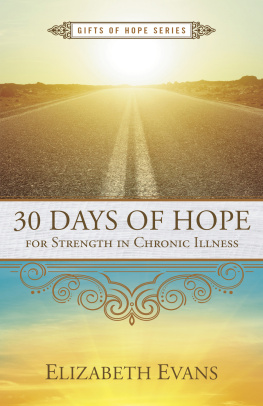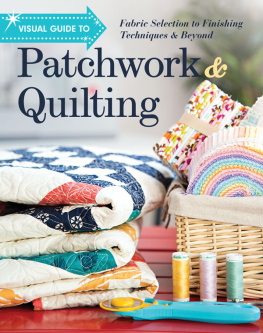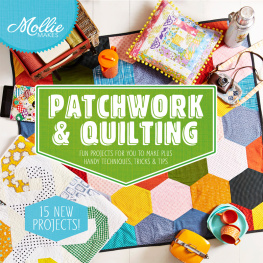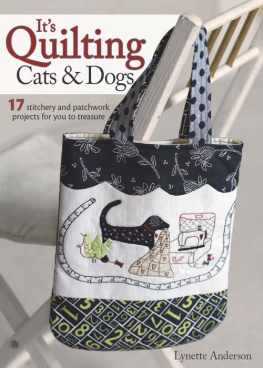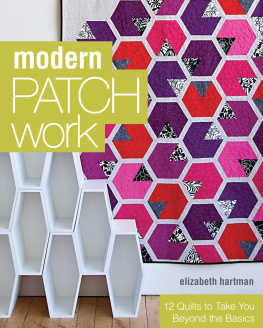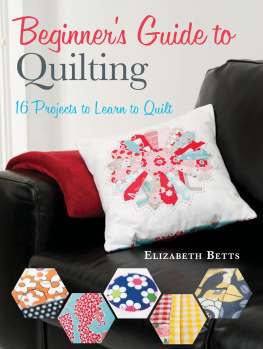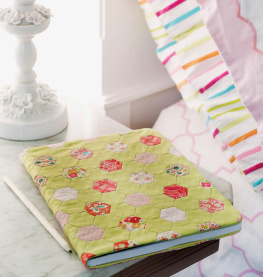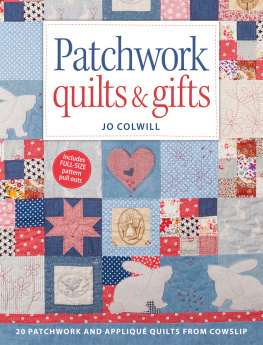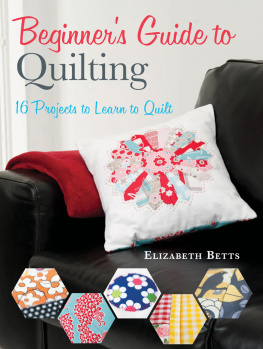Contents
Guide
the SIMPLE SIMON GUIDE to
PATCHWORK QUILTING
Two Girls, Seven Blocks, 21 Blissful Patchwork Projects
liZ Evans Elizabeth Evans

CINCINNATI, OHIO
DEDICATION
We have a lot in common: the same number of children, the same age, the same great educations, the same in-laws and of course the same name. But we also have something else in common: loyal husbands, wonderful children and loving parents. And it is to that endearing group of people that we dedicate this book. We love you with all of our hearts.
CONTENTS
INTRODUCTION
As we began researching the origins of the quilt blocks included in this book, we discovered that they all either found their beginnings or rose to popularity during the early 1800s. We also discovered that it is widely accepted by historians that the women who raised quilting to an art form and a cherished tradition during this era did so simply to mark significant events in the lives of their loved ones: birth, coming of age, marriage, moving, childbearing and death. The blocks that have become so iconic with frontier life and American tradition were created for the sole purpose of showing love and that seemed all too familiar to us.
Both of us were raised in different homes on opposite sides of the country. However, we both come from a long line of quilters, crocheters and crafters; from women who also created handmade gifts to mark the significant events in our own lives. From hand-crocheted blessing gowns to handmade baby blankets to hand-stitched wedding quilts, we find with each new period in our lives the handiwork of the women who came before us is always there.
It has been said many times that quiltmaking history is really quiltmaking herstory. Quilts show in remarkable detail the environment, conditions and ingenuity of the women who created them. The fabrics used give us clues about the economic status of these women and the supplies available to them. The patterns they chose to quilt tell us if they had the luxury of extra time in the evening for handiwork (as is evidenced by the intricate designs and embroidery of crazy quilts) or if time spent quilting was a luxury in and of itself (many frontier quilts were of the Nine Patch and Log Cabin variety). But whether the fabrics were the new prints of the day or scraps from tattered clothing, each quilt tells a beautiful story about love and the human spirit.
And it is not just quilts from the 1800s that tell such compelling storiesthese histories continue to be shared. As we look back at our own cherished items from mothers, grandmothers and aunts, we recognize variations in supplies, styles and details that each tell their own personal stories. And we appreciate these objects all the more.
Quilting has always been a powerful art form. The 1800s were a time of great migration and women could only carry with them a precious few belongings. Not surprisingly, quilts were always among those possessions. Not only did quilts serve a practical purpose but they served possibly an even more important purpose, surrounding people with both much needed warmth on treks across an untamed frontier and with comfort, love and the memories of the women who cared for them most.
We believe that we need the art of quilting just as much today as we did in the 1800s, both for ourselves and for our children. We admire the talent, creativity and determination of the quilters who have come before us, and we hope to keep the tradition alive in our own homes and pass it on to others. We created this book in an effort to keep this grand tradition alive, and we sincerely hope you find it both helpful and informative.
Elizabeth and liZ
Chapter One
TOOLS & TECHNIQUES
As you begin (or continue) to create patchwork quilts, you will quickly discover that not only do you have a set of favorite tools to work with but that you have favorite techniques, too. Because of this, we pulled together all of our favorite tools and the techniques in one place to help you get started.
In this chapter we will walk you through the processes that we use most often (like sewing, binding, basting and constructing quilt backs). We refer back to the methods outlined in this chapter often and hope that you will find them helpful.
We understand that there as many ways to make a quilt as there are quilt patterns. If, for instance, our method for adding sashing is different than the way your grandmother taught you, thats OK! Go with what you know! (Or be daring and try something new.) Either way will work. In quilting, there is no technique that can only be accomplished one way. Patchwork quilting is an art form and, as such, is made all the more beautiful by the individuality expressed not only in the pattern and fabric selections but in the methods of construction, as well. So, enjoy the process and feel free to experiment with the techniques.
TOOLS
While you dont need every tool on this list to make the projects in the book, there are a few basic tools.
Basic Sewing Tools
A rotary cutter, when paired with a rotary mat and quilting ruler, is one of the fastest and most accurate methods for cutting fabric. Well go over how to use them in a bit.
Fabric scissors are a must. Make sure you dont use your fabric scissors to cut anything else (paper will dull them quickly).
You can use any type of straight pin to pin your pieces together before sewing. Take care to remove them as youre sewing: stitching over a pin can ruin your machine.
There are many different threads on the market. For the projects in this book, any all-purpose thread will work. Choose one in a color that coordinates with your project.
Always keep a seam ripper nearby. Mistakes are part of the process, and a seam ripper is a quick and relatively painless way to remove stitches.
Youll need a removable fabric marker or fabric chalk for drawing stitching lines on your projects from time to time. If you plan on quilting any of your projects with your machine, youll draw the quilting lines on first, then wash them away.

Sewing Machine Accessories
Aside from a trusty sewing machine, we recommend a few specialty sewing machine feet to help make sewing easier. A walking foot is great for doing the actual quilting on a project. A zipper foot is helpful when making the Flying Geese Zipper Pouch.
Nonessential Tools
You can certainly make do without these tools, but they are helpful. Wonder Clips are great when you need to hold multiple layers together, like a quilt top, batting and backing!
Since most of the projects in this book are sewn with a 14" (6mm) seam allowance, having a 14" (6mm) piecing foot for your sewing machine will help ensure accurate seam allowances.
Squaring-up rulers make squaring your blocks quick and easy. Look for both the Half-Square Triangle ruler and the Flying Geese ruler.
How to Cut Fabric
A cutting mat, quilting ruler and rotary cutter are very helpful for cutting fabric. We have found over the years that the more precisely you cut your fabric, the better the quilt turns out in the end. You will have less trimming to do and a more accurate quilt block. The easiest way to cut fabric is to cut it into strips and then cut your strips into individual squares. Heres how to do that:


